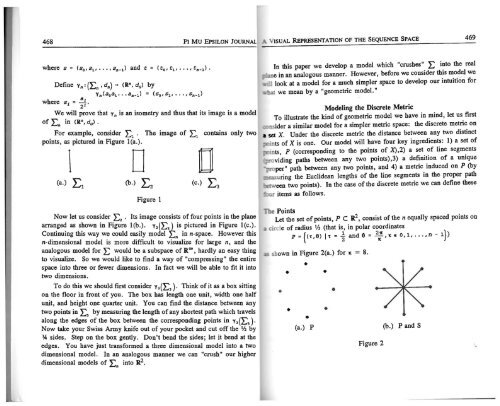Vol. 10 No 6 - Pi Mu Epsilon
Vol. 10 No 6 - Pi Mu Epsilon
Vol. 10 No 6 - Pi Mu Epsilon
- No tags were found...
Create successful ePaper yourself
Turn your PDF publications into a flip-book with our unique Google optimized e-Paper software.
468 PI MU EPSILON JOURNAL<br />
VISUAL REPRESENTATION OF THE SEQUENCE SPACE 469<br />
Define Yn: (En, d.,) -<br />
(R", dG) by<br />
y n (a 0<br />
a 1<br />
••• a.,_J = (s 0 , s 1<br />
, ••• , sn_ 1 )<br />
ai<br />
w h ere s 1 = 1<br />
.<br />
2<br />
We will prove that y n is an isometry and thus that its image is a model<br />
of :E.. in (It", dG) •<br />
For example, consider El . The image of L 1<br />
points, as pictured in Figure l(a.).<br />
l D D<br />
Figure 1<br />
contains only two<br />
<strong>No</strong>w let us consider ~ . Its image consists of four points in the plane<br />
arranged as shown in Figure l(b.). y 3 (L ) 3<br />
is pictured in Figure l(c.).<br />
Continuing this way we could easily model Ln in n-space. However this<br />
n-dimensional model is more difficult to visualize for large n, and the<br />
analogous model for :E would be a subspace of Reo, hardly an easy thing<br />
to visualize. So we would like to find a way of "compressing" the entire<br />
space into three or fewer dimensions. In fact we will be able to fit it into<br />
two dimensions.<br />
To do this we should first consider y 3 (L 3<br />
). Think of it as a box sitting<br />
on the floor in front of you. The box has length one unit, width one half<br />
unit, and height one quarter unit. You can find the distance between any<br />
two points in ~ by measuring the length of any shortest path which travels<br />
along the edges of the box between the corresponding points in y 3 (L 3<br />
)·<br />
<strong>No</strong>w take your Swiss Army knife out of your pocket and cut off the 1 /2 by<br />
1.4 sides. Step on the box gently. Don't bend the sides; let it bend at the<br />
edges. You have just transformed a three dimensional model into a two<br />
dimensional model. In an analogous manner we can "crush" our higher<br />
dimensional models of :E.. into R 2 •<br />
In this paper we develop a model which "crushes" :E into the real<br />
e in an analogous manner. However, before we consider this model we<br />
look at a model for a much simpler space to develop our intuition for<br />
we mean by a "geometric model."<br />
Modeling the Discrete Metric<br />
To illustrate the kind of geometric model we have in mind, let us first<br />
ider a similar model for a simpler metric space: the discrete metric on<br />
a set X. Under the discrete metric the distance between any two distinct<br />
- ts of X is one. Our model will have four key ingredients: 1) a set of<br />
• ts, p (corresponding to the points of X),2) a set of line segments<br />
viding paths between any two points),3) a definition of a unique<br />
per" path between any two points, and 4) a metric induced on P (by<br />
ring the Euclidean lengths of the line segments in the proper path<br />
·een two points). In the case of the discrete metric we can define these<br />
items as follows.<br />
Points<br />
Let the set of points, P C R 2 , consist of the n equally spaced points on<br />
circle of radius 1 /z (that is, in polar coordinates<br />
p = { ( t , 6) I t = ~ and 6 = 2 : , x E 0, 1, ... , n - 1})<br />
shown in Figure 2(a.) for x = 8.<br />
•<br />
• •<br />
• •<br />
•<br />
•<br />
•<br />
(a.) p<br />
(b.) P and S<br />
Figure 2 ·.
















